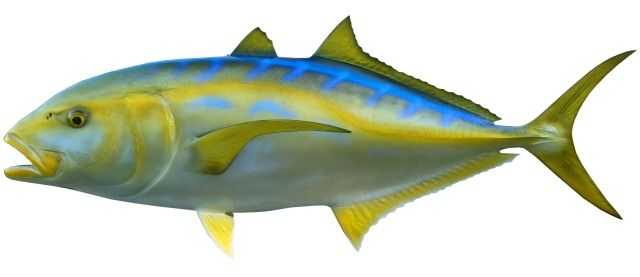Yellow Jack

Species Details
Caranx Bartholomaei
Carangidae
Perciformes
Offshore Reefs, Corals, Open Water
1 - 31 lbs.
1" - 39"
Description
Also known as the Coolihoo, the Yellow Jack isn’t much of a popular fish despite its size. Though a lot of people end up catching it, the Yellow Jack is often overlooked because its cousins are larger. The Yellow Jack is oblong shaped and compressed laterally, although its body from the top looks more curved outward.
Its fins have a glassy appearance to them and are often gold-yellow to golden brown in color. A Yellow Jack also gets its name from the streaks of yellow covering its body. Although some parts of its body have cerulean blue tints, the blue of a Yellow Jack may seem brighter because of the yellow contrast. The Yellow Jack’s dorsal fin is split into two parts: its first portion being split into 7 spines while the second portion only has 1 spine but made up of 21-24 rays. Its pectoral fins are sickle-shaped and are slightly longer than the head.
Diet
Yellow Jacks are predators and carnivores. They prey on smaller fish although they also go for animals that lie deeper under the water usually near the benthic zone. When the Yellow Jack hunts for food, they usually use a larger species of fish to cause a commotion. Once there’s enough commotion, the Yellow Jack swoops in and devours the stragglers that are trying to escape.
Size
Yellow Jacks can grow quite big. They grow as long as 39 inches and weigh 31 pounds. They become sexually mature from 9 inches to 12.6 inches.
Interesting Facts
- The older they are, the more yellow the Yellow Jacks get.
- As a juvenile, Yellow Jacks also have vertical bars covering their body. These eventually fade into blotches as they grow older.
- Yellow Jacks are known as a high-risk species.
- They are known carriers for ciguatera toxins which are fatal to humans.
- Yellow Jacks have a tendency to scavenge especially when they know that the group of big fish they’re following will rise up as the winner.
- They are also known to be opportunistic foragers, making the most out of the commotion to eat.
- Yellow Jacks only taste fishy because some people forget to remove the bloodline.
- According to some experienced anglers, the bloodlines of a Yellow Jack can make them taste extremely fishy. Removing it will make it taste better.
Fishing Techniques
Some people say that they end up catching Yellow Jacks without intending to at all.
However, if you really want to narrow down the selection of fish attacking your bait, some anglers recommend using Pilchard. Yellow Jacks normally get excited at the sight of the Pilchard bobbing through the water. Its one of the best ways to catch them is actually via trolling.
Since Yellow Jacks are pretty fast, watch how your jig or bait responds in the water. The moment you see it coming, slightly pull it back. And the moment they snap, reel it in as fast as you can! Remember, these Yellow Jacks, being fast swimmers and also opportunistic predators, will only stay if the opportunity still suits them. If they are fast enough to swipe the bait, you’ll have to reload it again.
Another thing to take note of catching Yellow Jack is using lightweight equipment. Usually, a 10-15-pound line will do so you can feel the strikes a lot easier.
Habitat
Yellow Jacks swim around offshore reefs. They also like hanging around seagrass beds or hiding among jellyfish. Yellow Jacks are also fond of a particular plant called a Sargassum weed which is normally found among corals. Yellow Jacks despite their solitary nature do sometimes travel in schools but only because they’re hungry.







